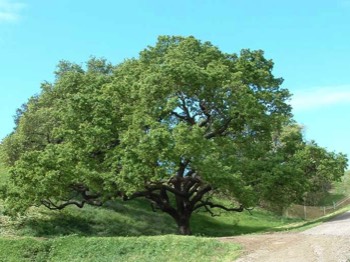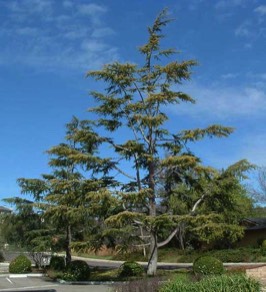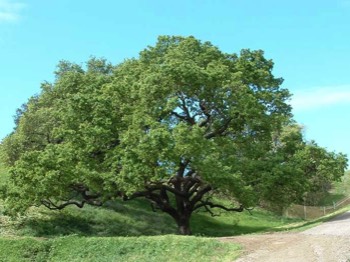Mature Tree Care
Pruning Mature Trees
Pruning mature trees is very common in the Santa Ynez Valley. There is an abundance of these old trees. Some of them have never been pruned and are hundreds of years old. So it is very important that these trees are treated properly. Using sound trimming techniques will insure that these majestic trees will survive for years to come. Once again, avoid topping, lion tailing and over trimming.
Pruning mature trees is very common in the Santa Ynez Valley. There is an abundance of these old trees. Some of them have never been pruned and are hundreds of years old. So it is very important that these trees are treated properly. Using sound trimming techniques will insure that these majestic trees will survive for years to come. Once again, avoid topping, lion tailing and over trimming.

Reasons for Pruning
Since each cut has the potential to change the growth of the tree, no branch should be removed without a reason. Common reasons for pruning are to remove dead branches, to remove crowded or rubbing limbs, and to eliminate hazards. Trees may also be pruned to increase light and air penetration to the inside of the tree's crown or to the landscape below. In most cases, mature trees are pruned as a corrective or preventative measure.
Routine thinning does not necessarily improve the health of a tree. Trees produce a dense crown of leaves to manufacture the sugar used as energy for growth and development. Removal of foliage through pruning can reduce growth and stored energy reserves. Heavy pruning can be a significant health stress for the tree.
Heavy pruning just after the spring growth flush should be avoided. This is when trees have just expended a great deal of energy to produce foliage and early shoot growth. Removal of a large percentage of floliage at this time can stress the tree.
Pruning Techniques
Specific types of pruning may be necessary to maintain a mature tree in a health, safe and attractive condition.
Since each cut has the potential to change the growth of the tree, no branch should be removed without a reason. Common reasons for pruning are to remove dead branches, to remove crowded or rubbing limbs, and to eliminate hazards. Trees may also be pruned to increase light and air penetration to the inside of the tree's crown or to the landscape below. In most cases, mature trees are pruned as a corrective or preventative measure.
Routine thinning does not necessarily improve the health of a tree. Trees produce a dense crown of leaves to manufacture the sugar used as energy for growth and development. Removal of foliage through pruning can reduce growth and stored energy reserves. Heavy pruning can be a significant health stress for the tree.
Heavy pruning just after the spring growth flush should be avoided. This is when trees have just expended a great deal of energy to produce foliage and early shoot growth. Removal of a large percentage of floliage at this time can stress the tree.
Pruning Techniques
Specific types of pruning may be necessary to maintain a mature tree in a health, safe and attractive condition.
Crown cleaning is the removal of dead, dying, diseased, crowded, weakly attached and low-vigor branches from the crown of a tree.
Crown thinning is the selective removal of branches to increase light penetration and air movement through the crown. Thinning opens the foliage of a tree, reduces weight on heavy limbs, and helps retain the trees natural shape.
Crown raising removes the lower branches from a tree in order to provide clearance for buildings, vehicles, pedestrians and vistas.
Crown reduction reduces the size of a tree, often for clearance for utility lines. Reducing the height or spread of a tree is best accomplished by pruning back the leaders and branch terminals to lateral branches that are large enough to assume the terminal roles (at least one-third the diameter of the cut stem). Compared to topping, this helps maintain the form and structural integrity of the tree.
Crown thinning is the selective removal of branches to increase light penetration and air movement through the crown. Thinning opens the foliage of a tree, reduces weight on heavy limbs, and helps retain the trees natural shape.
Crown raising removes the lower branches from a tree in order to provide clearance for buildings, vehicles, pedestrians and vistas.
Crown reduction reduces the size of a tree, often for clearance for utility lines. Reducing the height or spread of a tree is best accomplished by pruning back the leaders and branch terminals to lateral branches that are large enough to assume the terminal roles (at least one-third the diameter of the cut stem). Compared to topping, this helps maintain the form and structural integrity of the tree.
How much should be pruned?
The amount of live tissue that should be removed depends on the tree size, species, and age, as well as the pruning objectives. Younger trees will tolerate the removal of a higher percentage of living tissue than mature trees. An important principle to remember is that a tree can recover from several small pruning wounds faster than from one large wound.
The amount of live tissue that should be removed depends on the tree size, species, and age, as well as the pruning objectives. Younger trees will tolerate the removal of a higher percentage of living tissue than mature trees. An important principle to remember is that a tree can recover from several small pruning wounds faster than from one large wound.

Mature trees should require little routine pruning. A widely accepted rule of thumb is never to remove more than one fourth of a tree's leaf bearing crown. In a mature tree, pruning even that much could have negative effects. Removing even a single, large-diameter limb can create a wound that the tree may not be able to close. The older and larger a tree becomes, the less energy it has in reserve to close wounds and defend against decay or insect attack. The pruning of large, mature trees is usually limited to the removal of dead or potentially hazardous limbs.
Wound Dressing
Wound dressings were once thought to accelerate wound closure, protect against insects and diseases, and reduce decay. However, research has shown that dressings do not reduce decay or speed closure, and rarely prevent insect or disease infestations. Most experts recommend that wound dressings not be used. If a dressing must be used for cosmetic purposes, then only a thin coating of a nontoxic material should be applied.
Q: My oaks have never been pruned. Do they need to be pruned, and if so, how?
A: Pruning can be used to manage tree safety, improve aesthetics, extend useful life span, manage certain pest problems and minimize conflicts with people, buildings, vehicles and power lines. When improperly done, it destroys natural shape and beauty, creates hazards, causes stress, reduces longevity and increases cost and reduces property value. Trees are routinely mis-pruned by well-intentioned people who don't understand how trees grow or respond to pruning. They are often motivated by fear of tree failure as trees grow in size or the misconception that trees need to be pruned to maintain health.
Pruning may not be desirable or beneficial. There is always some negative impact, at least temporarily. When done improperly, pruning can be destructive. Severe (hard) pruning can kill or seriously weaken trees by removing too much foliage. This diminishes food production (photosynthesis) causing stress, which may result in energy depletion, dieback, increased susceptibility to pests, or decline. Problems, however, seldom develop when pruning cuts are few in number, kept small and properly made. Damage, of course, depends on extent of pruning, size of wounds, time of year, and tree health prior to pruning. Pruning can also alter branch spacing and attachment strength, architecture (shape, foliage, density and distribution), and susceptibility to decay. Thus, trees should be pruned only as needed to accomplish the desired goal. Some goals, however, may be incompatible with tree health.
Important concepts to consider when pruning
- Pruning large trees is both dangerous and difficult; It is best left to professionals, preferably someone certified by the Western Chapter of the International Society of Arboriculture.
- Prune only as needed.
- Have a valid reason to prune each branch.
- Remove as little foliage as possible particularly for an older or declining oak.
- Prune with the health of the tree in mind.
- Remove dead branches if they pose a safety hazard to people, property or structures. Dead branches can be left in trees in naturalized settings for wildlife purposes.
- Keep cuts small and few in number. Don't stub unwanted tree branches; remove branch where they originate.
- Don't cut branches flush to the trunk or branch; leave the collar or swollen area at the branch base intact. Removal of the collar will encourage decay.
- Wound dressing does not prevent decay and should not be used on pruning cuts.
- Prune in late winter to early spring, or early to midsummer. Avoid pruning when the leaves are forming and in the fall when leaves are shedding.
- Dead and weak branches can be removed at any time.
- Correct extensive structural problems gradually.
- Avoid thinning interior foliage.
- Don't alter natural shape.
- Avoid excessive crown raising (removal of lower branches, some times called lion-tailing).
- Don't top oaks and other trees to reduce tree height or spread.
